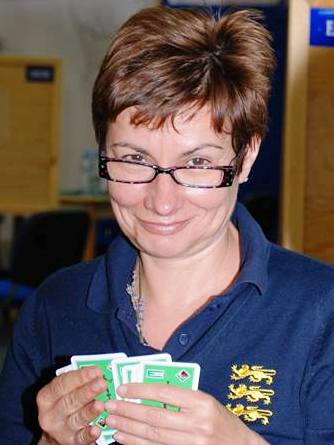



On some auctions, we attempt to work together with partner to win the contract or at least push the opponents to an uncomfortable level. But there are times when we know that partner is going to face a difficult decision—either with their next bid or on opening lead. In these situations, we should think about how to help partner make a better decision. In this article, the third in our series on Partnerships, we look at how we use the bidding to help partner take better actions later in the deal.
Let’s look at some actions we can take to help partner!
When we have found a fit and invite game, we give partner a decision – to accept to decline our invitation. Sometimes partner will get this decision correct, while other times partner will get this decision wrong. We should help partner make the best decision possible.
| You | Partner |
|---|---|
| 1♥ | 2♥ |
| 3♥ | ? |
In this auction, our 3♥ bid invites partner to bid 4♥ (unless you have a special agreement otherwise). Partner is left to blindly guess if they should pass 3♥ or bid on to 4♥. The only information that partner has to help them make this decision is whether they have a maximum or minimum for bidding 2♥. This leaves partner with a decision they are likely to get wrong much of the time.
Instead, we should invite game in a more effective way:
These bids help partner make a better decision. A Help Suit Game Try asks partner to focus not just on their total HCP, but instead to focus on this side suit and their trump holding. A bid like this helps partner better evaluate their hand.
Partner should suspect that we have some length in our “help suit” and that we are often short in the other two suits. Partner can then better understand the values (or lack of value) or Kings, Queens, and Jacks, in these side suits.
This 2♥ bid shows about 6-10 points and a fit for partner. I could have anywhere from 3-5 card support for Opener’s ♥ suit.
| You | Partner |
|---|---|
| 1♥ | 2♥ |
| 3♣ | ? |
♠K4
♥AQ983
♦K7
♣A654
With this hand we would make a Help Suit Game Try into 3♣.
Let’s look at some example hands for partner.
Partner accepts our Game Try with these hands:
♠A983
♥KJ73
♦9843
♣5
Partner has good trumps, an outside Ace, and good help in our side suit (a singleton and a 4th trump) so they should bid game. This is the stuff we need.
♠J73
♥K83
♦53
♣KQ843
Partner accepts our game try with the known Double Fit.
Partner declines our Game Try with this hand:
♠QJ82
♥J83
♦QJ7
♣Q73
Even though partner is at the top of their range, having a lot of HCP is not always good. They need to be the “right HCP”. These are not, and we will struggle to make even 3♥.
We can strive to help partner with their decision making in competitive auctions as well. In these auctions we are not sure if our side is going to win the contract or end up on Defense. So we must consider making bids that help them decide how high to bid (either by finding a fit or helping them re-evaluate their hand) and taking actions that are going to help them get off to the best opening lead.
One of the actions we can take to help partner is to make an overcall with sub-minimum values:
| RHO | You |
|---|---|
| 1♦ | ? |
♠Q43
♥Q9842
♦8
♣K983
Here we have 7 HCP and a 5-card suit, but it is best to Pass and not come into the bidding (this is especially true if we are vulnerable.
♠943
♥AK1082
♦8
♣10983
With this hand we have the same 7 HCP and the same distribution, but we should overcall this time, because of our suit quality. With this hand, we stretch and overcall 1♥. Though we do not have many HCP, we want partner to lead a ♥, we cannot help in any of the other suits, and the best way to make that happen is to make an overcall.
Another way that we can help partner with their opening leads (or sometimes even to get them to further compete in the bidding) is to effectively use a Double. The best way we can use our Double to help partner make better opening leads is to make frequent Lead Directing Doubles.
A Lead Directing Double is usually a double of an artificial bid. This is not a Takeout Double, asking partner to bid a new suit; this shows the suit that we doubled and suggests to partner that they lead that suit or even compete in the bidding in this suit if they have a large fit.
| Opener | Partner | Responder | You (Advancer) |
|---|---|---|---|
| 1NT | P | 2♣ | X |
This double of Stayman asks partner to lead a Club. It helps give partner a safe lead. We should make this double with a suit like ♣KQT83. But sometimes with a better hand we might make this double with a slightly weaker suit.
| Opener | Partner | Responder | You (Advancer) |
|---|---|---|---|
| 1NT | P | 2♦* | X |
Similarly, this double asks for a ♦ lead.
| Opener | Partner | Responder | You (Advancer) |
|---|---|---|---|
| 1♦ | P | 1♠ | P |
| 2♣ | P | 2♥* | X |
Here we double 4th suit forcing to get partner off to a Heart lead.
If we are active in our use of lead directing doubles then partner has a strong inference to not lead a particular suit if we have a chance to make a lead directing double and choose not to do so.
| Opener | Partner | Responder | You (Advancer) |
|---|---|---|---|
| 1♦ | P | 1♠ | P |
| 1NT | P | 2♣* | P |
| 2NT | P | 3NT | P |
There are two “unbid” suits – Clubs and Hearts. Here, partner has a strong inference to lead Hearts, since we had a chance to double 2♣ to ask for a Club lead and did not. Our failure to take an action gives partner information, just as our actions do. These Negative Inferences are a powerful partner of communicating with partner and helping them make better decision.
Remember when you take an action - especially one when we are not likely to win the contract, then we should stretch to take actions that are going to help partner with their future decisions. Keep working on helping your partner, they often need the help! The more you keep this in mind, the more interesting and useful actions you will think of and take.
About the Author
Robert Todd is a professional player and teacher who you’ll find all over North America (and the world). He's the founder of Adventures in Bridge and you'll find him hosting events, either virtual or in-person, almost every week of the year! Robert's also the president of the ACBL Educational Foundation where he's working to build an institution to shepherd the long term good of bridge!




Very good logic
Aside from the error in bidding 1 club as a response to 1 spade , what did 2 clubs as a response to that mean? It would be very helpful to explain All the bids ( correctly !)
amnon7774@gmail.com
2 clubs is "other minor forcing", an artificial bid. The 1 club rebid is an obvious misprint.
You're right there was an annoying typo. Response should've been 1NT
A preemptive hand in clubs -- weak.
We play jump shift as weak and preemptive.
Very nice expression. I just wonder if we do double of two hearts there is possibility risk of opponent passing leading to game instead of bidding further
If the last example is meant to be a bidding sequence ending in 3NT there is a typo in that auction. If it is meant to show multiple bidding sequences, as it is formatted it is confusing.
You're right Jim - thanks for letting us know. It should be 1NT not 1♣ - I've updated it.
Very informative for me as a newcomer to Bridge. Thanks for presenting this.
Excellent info
Will discuss with partners
Thank you Robert for teaching me new information about leading our partners in bidding, and leading cards
Thank you, I will use these lead directing doubles.
This was very informative and helpful and I will pass it on to my partner.
Thank you!
Thanks
Good thoughts.
if opener bids 1D & responder bids 1S, opener cannot bid 1C
Agree !
Very useful
That was a great lesson. Thank you
Thanks Robert. I made sure all my partners read this.
Yeah, but oops in showing Opener with a 1C rebid. Can’t do over Partner’s 1S response.
What happens if the opponents leave the double in and they make the bid, doubled?
On the hand where you have seven high card points and a five card suit and you decide to pass, what if partner is sitting there with 19 points and just wanted you to bid so they could go to game. You might miss game.
Actually, I will answer my own question. You don’t have enough HCP to open for the partnership. Partner has not had a chance to bid yet. Wait and see what they do before bidding…. (Yesterday I thought I was a responder….)
Actually, passing with this hand nv is out of question. That is how you get outplayed.
very helpful, thanks
Like reading different rules
All information is excellent. I printed out every page for study and game inclusion.
Great teaching I always learn from Robert’s articles
If a double of Stayman shows clubs what do you bid with -
S -A K Q 6 3 H - 10 6 D - K Q 7 5 C - A 5?
Very interesting and helpful. Thnks
On the first example of 1H - 2H - 3C, you stated partner did not have another bid, so is he supposed to pass his partner's 3C bid?
Excellent advice. And it’s not complicated, but very clear teaching. Thank you
Very interesting
Robert, can you do an article on "suit preference" please?James Maher
Good information. Thank you.
A very illustrative article, which I intend to incorporate into my bidding system
Very nice problems and solutions.
Thanks